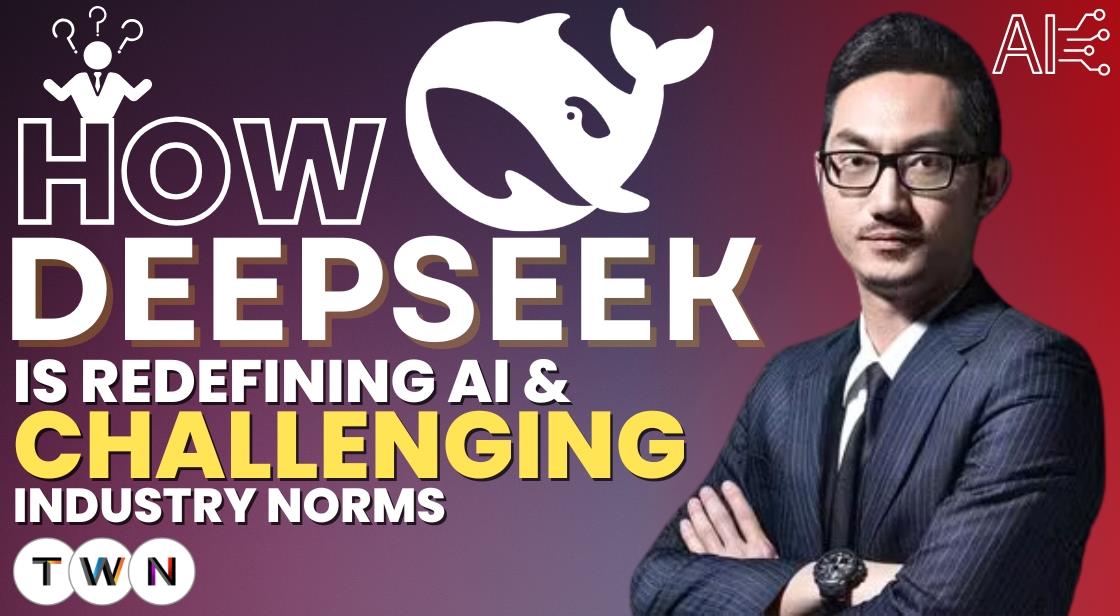How DeepSeek Is Redefining AI and Challenging Industry Norms

Blog Post
In a remarkable turn of events, DeepSeek, a Hangzhou-based AI startup founded in 2023, has rapidly ascended to prominence with the release of its language model, DeepSeek-R1, on January 20, 2025.
This innovative model has garnered significant attention for its advanced reasoning capabilities and cost-effective development, positioning it as a formidable competitor to established AI systems from industry leaders like OpenAI and Google.
Notably, DeepSeek-R1 was developed with a budget of approximately $6 million, a fraction of the expenditure typically associated with high-performance AI models. Its open-weight design has further facilitated widespread adoption among researchers and developers.
The model's proficiency in complex reasoning tasks, particularly in mathematics and coding, has been lauded by experts, underscoring its potential to redefine industry standards.
The swift rise of DeepSeek-R1 has not only disrupted the AI sector but also prompted a reevaluation of existing strategies among tech giants, highlighting a shift towards innovation and efficiency over sheer financial investment.
This blog post provides a concise and informative overview of DeepSeek's groundbreaking AI model, highlighting its key features, impact on the tech industry, and implications for the future of AI development.
DeepSeek: A Game-Changer in Artificial Intelligence
DeepSeek, a groundbreaking AI startup based in Hangzhou, China, has captured global attention with its revolutionary language model, DeepSeek-R1. Released on January 20, this cutting-edge model competes with industry leaders like OpenAI’s GPT-4o while being significantly more cost-effective.
With exceptional capabilities in chemistry, mathematics, and coding, DeepSeek-R1 is ushering in a new era of artificial intelligence (AI), attracting excitement from scientists, researchers, and investors alike.
What is Artificial Intelligence?
Artificial intelligence (AI) enables machines to learn, reason, and solve problems by analyzing vast amounts of data and recognizing patterns. This technology powers applications ranging from chatbots like ChatGPT to complex scientific simulations.
Generative AI, such as DeepSeek, utilizes large datasets to create new content, including text, images, and code. However, these tools also raise concerns about misinformation and embedded biases from training data.
Millions of users rely on AI for tasks such as writing emails, summarizing text, and answering questions. AI also assists in basic coding, studying, and problem-solving, making it an essential tool in today’s digital landscape.
Also Read: Top Free AI Tools to Boost Productivity and Creativity
What is DeepSeek?
Founded in late 2023 by Chinese hedge fund manager Liang Wenfeng, DeepSeek is among the many startups vying for dominance in the AI sector. Liang, often likened to Sam Altman of OpenAI, has positioned himself as a key advocate for AI investment and innovation in China. His hedge fund, High-Flyer, is dedicated to AI research and development.
DeepSeek has released several competitive AI models over the past year, with its V3 model gaining some industry attention. However, restrictions on sensitive topics related to the Chinese government raised concerns about its broader viability.
The launch of DeepSeek-R1, however, has changed the game. Its unexpectedly low operational cost and open-weight model have set it apart from competitors, making AI more accessible to researchers and developers worldwide.
The DeepSeek app has surged in popularity, surpassing ChatGPT on app store charts, with nearly two million downloads.
Why is DeepSeek Such a Big Deal?
AI is a power-intensive and expensive technology, requiring immense resources for development and operation. Tech giants like Meta plan to invest over $65 billion in AI this year, while OpenAI’s CEO, Sam Altman, has estimated that the industry will require trillions in investment to sustain growth.
DeepSeek’s ability to match leading AI models at a fraction of the cost—using less powerful chips—has disrupted conventional assumptions about AI investment. This shift suggests that innovation, rather than sheer financial power, could dictate the future of AI.
Tech investors and venture capitalists, including Silicon Valley icon Marc Andreessen, have hailed DeepSeek as a breakthrough. Andreessen described it as “one of the most amazing and impressive breakthroughs I’ve ever seen.” If DeepSeek’s technology can achieve top-tier AI capabilities with minimal investment, it could redefine the AI industry’s financial and technological landscape.
The Impact on the U.S. and Global AI Dominance
The United States has relied on export restrictions to maintain technological dominance, particularly by limiting China’s access to advanced AI chips. Just before leaving office, former President Joe Biden intensified these restrictions, aiming to curb China’s AI advancements.
However, DeepSeek’s success challenges this strategy, demonstrating that innovation can thrive even under tight constraints. The AI industry’s power dynamics are shifting, with China closing the gap with the U.S. in a way that was previously thought unlikely.
Financial markets have taken notice. Following DeepSeek’s launch, Nvidia’s stock plummeted 12% in premarket trading, alongside declines in Meta, Alphabet, Marvell, Broadcom, Palantir, and Oracle. This dramatic reaction underscores DeepSeek’s disruptive potential.
Unveiling a Cost-Efficient Innovation Strategy
What sets DeepSeek apart is its cost-efficient approach to AI development. Unlike most state-of-the-art AI models requiring vast financial and computational resources, DeepSeek-R1 was developed with just $6 million spent on hardware. In contrast, Meta’s Llama 3.1 405B required $60 million and eleven times the computational power.
This achievement represents a paradigm shift, proving that groundbreaking AI advancements do not necessarily require exorbitant investments. Instead, ingenuity and efficiency can challenge even the most entrenched norms of the industry.
DeepSeek: A Black Swan Event
DeepSeek’s rise has been described as a “black swan event”—a rare, unpredictable occurrence that disrupts industries or markets. Coined by Nassim Nicholas Taleb, the term refers to events that are unexpected, impactful, and rationalized only in hindsight.
Historically, AI advancements were thought to require vast budgets and exclusive access to top-tier infrastructure. DeepSeek’s success challenges this belief, proving that resourcefulness can rival even the most well-funded initiatives.
This has forced policymakers and industry leaders to reconsider their strategies for maintaining technological leadership in an era of rapid innovation.
DeepSeek’s achievements are particularly notable given U.S. export controls aimed at slowing China’s AI progress. This development has reignited global debates about the effectiveness of restrictive policies, demonstrating that innovation cannot be easily contained.
A Commitment to Transparency and Collaboration
Beyond its technical achievements, DeepSeek has distinguished itself with its commitment to transparency and collaboration. Its R1 model has been released as an “open-weight” system, allowing researchers worldwide to analyze and build upon its algorithms. Licensed under MIT terms, the model has been praised for its accessibility, though it stops short of being fully open-source due to undisclosed training data.
“The openness of DeepSeek is quite remarkable,” noted Mario Krenn, head of the Artificial Scientist Lab at the Max Planck Institute for the Science of Light. This contrasts with competitors like OpenAI, whose models have been criticized for their lack of transparency. By prioritizing openness, DeepSeek is fostering a culture of global cooperation in AI research and setting a new standard for the industry.
Who is Liang Wenfeng?
In just a few weeks, Liang Wenfeng, the 39-year-old founder of DeepSeek, has emerged as a defining figure in China’s tech landscape. His company’s breakthrough AI model has not only challenged Western AI dominance but also triggered a global selloff in tech stocks.
DeepSeek’s rapid ascent underscores Beijing’s determination to close the AI gap with the U.S., with Liang now seen as a key player in China’s next-generation tech ambitions. His influence was further solidified when he was invited to a closed-door symposium hosted by Chinese Premier Li Qiang on January 20, alongside top officials and business leaders.
Conclusion: A New Era in AI
DeepSeek’s emergence signals a profound shift in the AI industry. By demonstrating that high-performance AI can be developed with minimal investment, it has challenged the dominance of Western tech giants and raised questions about the future of AI innovation. Whether DeepSeek can sustain its momentum remains to be seen, but one thing is certain: the AI landscape will never be the same again.
You May Like
EDITOR’S CHOICE












